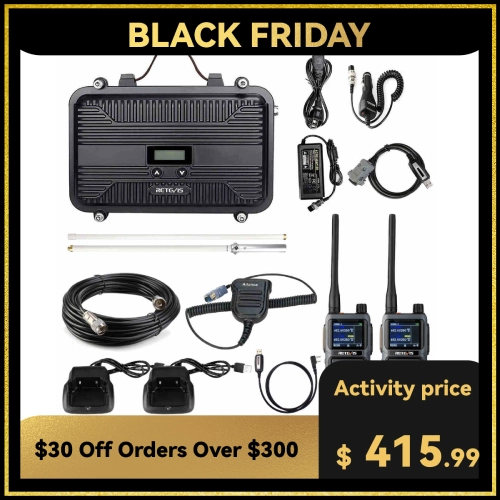Top 15 FAQs about GMRS Radios and GMRS Repeaters

Top 15 FAQs about GMRS Radios and GMRS Repeaters
GMRS radios, or General Mobile Radio Service radios, are increasing in popularity. One of the major benefits of utilizing GMRS is the ability to use a GMRS repeater for maximum range in difficult terrains. Here we have collected 15 frequently asked questions about GMRS radios and GMRS repeaters to help you understand them better.
Top 15 FAQs about GMRS Radios and GMRS Repeaters
Q1: Can I transmit on GMRS without a license?
A1: No, transmitting on GMRS frequencies without a valid license is illegal. You must have a license from the FCC before you can use a GMRS radio.
Q2: Does a Ham license cover GMRS?
A2: No, a Ham license only covers amateur radio frequencies, while a GMRS license is specific to GMRS. Additionally, a GMRS license covers your entire family, whereas a Ham license only applies to the individual license holder.
Q3: Is there a fee for a GMRS license?
A3: Yes, the GMRS license costs $35 for 10 years. This one license covers your entire family, so you only need one application for all immediate family members.
Q4: What radio frequencies can I use for GMRS?
A4: GMRS is allotted 30 frequency channels around 462 MHz and 467 MHz with a bandwidth of 25 kHz (20 kHz authorized bandwidth) or 12.5 kHz. 462 MHz channels can be used by GMRS licensees for simplex communication or repeater outputs. 467 MHz channels may only be used as repeater inputs, in conjunction with the 462 MHz channels as outputs.
Q5: What is a GMRS travel tone?
A5: The Channel 20, 462.675 MHZ, is the unofficial national emergency and traveler's assistance channel with a tone of 141.3 Hz, aka Travel Tone. The travel tone is simply an agreed channel and tone that can be used for travel assistance and emergencies.
Q6: Can GMRS communicate with FRS?
A6: Yes, GMRS can communicate with FRS radios on channels 1–7, as both services share the same frequency range. However, FRS radios should avoid channels 8–14, which are exclusive to FRS.
Q7: Can Ham radio communicate with GMRS?
A7: Yes, Ham radios can receive GMRS transmissions if they are capable of covering the GMRS frequency range. However, GMRS radios cannot legally transmit on Ham radio frequencies, and vice versa.
Q8: Can GMRS talk to CB radios?
A8: No, GMRS and CB radios use different frequencies. CB operates on 27 MHz AM, while GMRS uses 462/467 MHz FM. These frequencies are not compatible.
Q9: Can I use a CB antenna on a GMRS radio?
A9: No, CB antennas are designed for different frequencies than GMRS radios. Using the wrong antenna could reduce performance or even damage your radio.
Q9: How far will a 5 watt GMRS handheld radio transmit?
A9: Depends on the usage environment; in an ordinary city, about 2-3.5 miles, if the environment is open, the distance will be furthered.
Q10: How far will a 50 watt GMRS mobile radio transmit?
A10: Depending on the use environment, antenna gain, feeder attenuation, and other factors, the general distance is 6-10 miles; if you change a few open areas, the distance will be furthered.
Q11: How do GMRS repeater channels work?
A11: Repeater towers serve as both a radio receiver and a transmitter, receiving low-powered signals and then blasting them out with even more power. This allows users to communicate clearly while miles apart.
Q12: Do GMRS radios need to be programmed?
A12: The GMRS channels are already programmed and ready for use. When you connect a GMRS radio to the repeater, it’s an output signal (TX) for you but an input (RX) for the repeater. Likewise, when the repeater transmits a message, it’s an output for the repeater (TX) but an input for the receiving radios (RX).
Q13: What is a GMRS repeater?
A13: A GMRS repeater extends the range of GMRS radios by receiving a signal and re-transmitting it at a higher power. Repeaters are often placed on elevated locations like towers to maximize coverage.
- Q14: Do GMRS repeaters need to ID?
A14: No, repeaters don’t need to automatically ID if they are part of a private or closed repeater system. For example, on a family farm or ranch, the repeater would be identified under the family’s GMRS license.
Q15: How much does it cost to set up a GMRS repeater?
A15: Setting up a home GMRS repeater can cost less than $400 for a basic setup, such as the Retevis RT97S. This is suitable for use on farms, ranches, or private estates. Higher-end systems may cost more, depending on the specifications.
Retevis RT97S is a portable GMRS radio repeater for extending a GMRS handheld radio's repeater. It's a compact unit with an LED indicator light to alert you if a channel is busy. It has a built-in duplexer. This allows the unit to transmit and receive on the same antenna at the same time. Essentially, the duplexer contains circuits that isolate the transmitter from the receiver. This way, the transmitter's radio frequency doesn’t damage the receiver.
The RT97S GMRS radio repeater requires only one repeater antenna, which transmits and receives two way radios. It's very simple to set up. In the bundle, the RT97S repeater is equipped with a 7.2 dBi GMRS omni-directional base antenna. It also includes a 15-meter coaxial cable connecting the antenna—high-quality, low-loss—that is safely out of the way of getting stepped on or worn down by external forces.
Retevis RT97S with FRP Antenna and Mic Bundle
Retevis RT97S Repeater Bundle with RB17P GMRS Radio 2Pack
Related Blog: How to Mount a Radio Repeater for the Best Performance?








